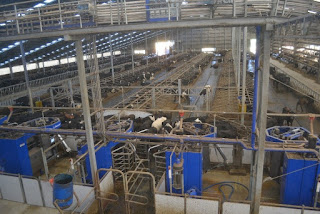 |
| The
Cross Slat drill pulled by the John Deere 8220 |
The group departed from the hotel in Ashburton this morning
and headed to RADFIELD FARM owned by David and Hilary Ward. This is an
irrigated crop and livestock farm situated on 385 hectares (951 acres). They
grow Italian Rye grass, White and Red clover, spinach, oats, winter wheat,
Brassica for grazing, and Corn salad (old French herb). They also grow
processing peas and carrots for seed. One way they were trying to be
sustainable was the water that was produced from a local vegetable processing facility
was irrigated back onto the crops. This process recycles nutrients back into
the cropping system. The producer also finishes 20,000 lambs a year, and 1,000
deer a year. They buy lambs at 30 kilograms (66 pounds) and feed to 48
kilograms (106 pounds), which they graze on the crops throughout the year. With
all of the sheep grazing on the crops, they also irrigate the land with the
capability of 5 millimeters a day. The pest management style is to protect the
beneficial insects rather than kill them.
 |
|
Students asking questions to the producer about the drill.
|
They also use no till practices on their land to ensure that
the soil will be farmable for future generations. David showed us a drill in
operation, the cross slot drill. This places a small seed to maintain friable
soil structure. Soil aeration is done by earthworms and root structures, making
a great platform to grow livestock and crops.
This practice builds organic material and
crops and fertilizer in one pass. The drill was designed in New Zealand by John
Baker and is used worldwide. This drill ensures the seed is not damaged by the
fertilizer but utilizes the fertilizer to the full effect. The drill does a
great job in cutting the residue and ensuring the seed is properly placed for
maximum germination.
 |
| Sheep
grazing on the farm |
 |
| Deer
grazing on the farm |
New Zealand is not too far from America and it is easy to
get a hold of equipment in the US. David got a piece of equipment from Nebraska
that he uses today which is a 2011 Case IH 8230. He utilizes this combine
because he believes it is gentle on the seed and is the best fit for his
operation. Another piece of equipment that he utilizes is a John Deer 8220.
 |
| Cattle
in the holding area with the chain arm above |
We then went our separate ways in the town to eat lunch and
do a little shopping. We met back on the bus to head to the dairy farm just a
little bit out of town. Ted and Sue have 380 hectares (940 acres) on the
property they currently have 5 pivots and working towards 6. When we first
pulled up, the milk truck was collecting the milk to be sent to Fonterra. Fonterra runs similarly to a coop in the US. We headed to the parlor where we
learned that he had a 70 cow rotary parlor, and, in the peak of milking, he can
milk 1,500 cows in 4 hours. All of the cattle have an RFID ear tag so the
workers know who is in the parlor at what time. This information can be used
for effective herd management including breeding and dry off. They had the Kiwi
cross (Holsteins and Jerseys), that produces a fat content of 5.5 and a protein
of 4.5 on 4,500 liters of milk. The cows are brought into the holding area, and
the gates within the holding area can be manipulated using a touch screen
computer. When the cows are stubborn and do not want to go into the parlor, an
automated chained arm moves the cattle towards the parlor so there is one less
person needed.
To reduce mastitis, they
use either a short term sealer or a long term sealer depending on the severity
of the infection. They also used Fodder Beets as a grazing supplement that the
cattle love to eat in the winter months.
 |
| Worker
putting milkers on the cow |
New Zealand farmers are driven to be more efficient because
the government mandates it. They have pushed the farmers to minimize pollution and
maximize production. Both operations have transitioned into some of the most
advanced technologies to manage their inputs. This includes transitioning from
flood dike to center pivot irrigation.
 |
| The
group standing in the Fodder Beet field |
Cody, Jacob, Katelyn











Comments
Post a Comment